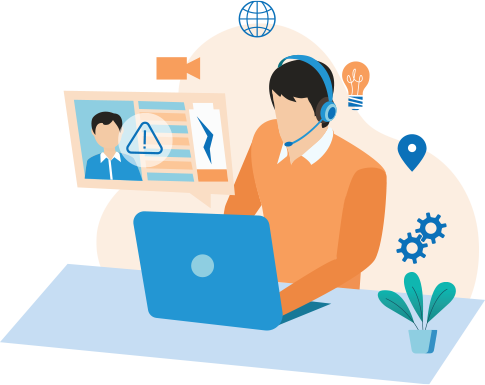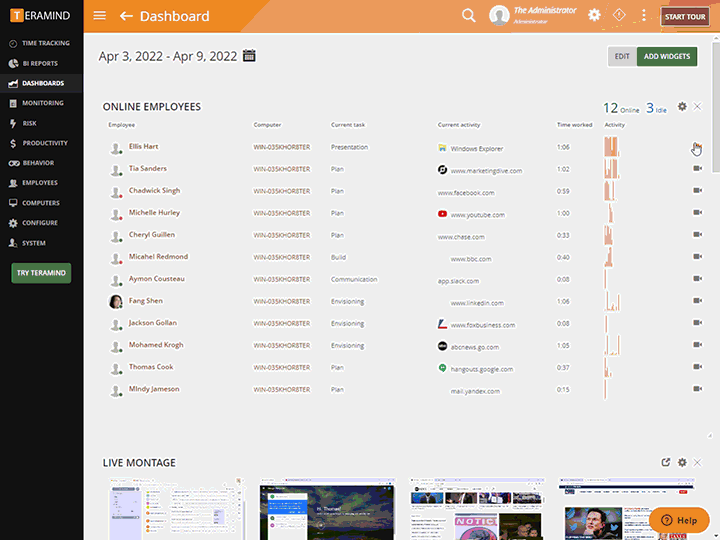It's a kind of software that allows organizations to monitor, trace, and record the activities of their employees. Employers can gather data about employee behaviour, including the number of keystrokes, web usage and applications, screenshots and more. The primary purpose of employee monitoring software is to boost productivity, make sure that employees are in compliance with policies, protect sensitive data, and address security concerns. There are a variety of factors to take into consideration when selecting software for monitoring employees. Take note of these crucial points: Features. Determine the features that you require based on your organization's needs. Common features include blocking of websites keys, keystroke logs, applications use tracking, and monitoring of emails. Prioritize the features that align with your monitoring objectives.
Privacy and Compliance: Make sure the software adheres to all legal and ethical guidelines on employee monitoring. Learn about the applicable laws and regulations in your jurisdiction, such as data protection and privacy laws. Look for software that is clear and customizable features that protect the privacy rights of employees.
User-Friendliness: Consider the program's accessibility and ease of use. A user-friendly interface as well as a simple installation process will cut down on time and simplify implementation. It is recommended to look for dashboards that are customisable and reporting tools that permit you to effortlessly analyze the data you have taken.
Integration and Compatibility- Verify that the software is seamlessly integrated with your current IT infrastructure and with the software you are using including operating systems and email clients, as well as tools for managing projects, as well as collaboration platforms. Compatibility permits seamless monitoring of your systems, without disrupting normal operations.
Data Security - Review the security measures taken by the program to safeguard the data it collects. Data encryption, storage within a safe location, access control, and the compliance with security standards are all essential. Verify that the vendor of software has a good security record and reliable security practices for data.
Scalability- Consider the ability of the software to support your company's expansion. If you anticipate expanding your workforce or opening new locations, select software that will easily scale up to meet your evolving needs.
Reporting and Analytics The software's reports and analytics features. You should look for features that give you a comprehensive view of the productivity of employees, their allocation of time, and trends. Analytics and reports that can be customized to assist you in making better decisions and help you identify areas for improvement.
Customer Support: Evaluate how well the vendor provides customer support. Examine their availability and technical support. If you've got a reliable customer service team, they will be able to provide quick help whenever issues occur.
Cost- Examine the pricing structure of the software. Are you paying a one-time payment, a subscription or depending on the usage? Understand the pricing model that includes any additional charges for support updates or additional features. You should balance your budget as well as the worth of features against what you can afford.
Transparency and communication between employees - Establish an open and transparent dialogue to your employees regarding the use and implementation of software for monitoring. Be clear about the goal, scope of work, and the expectations regarding the monitoring. Inform them of how they can be protected and how they can address the concerns of your clients.
Think about these points to make an a well-informed decision. Choose the employee monitoring software that will meet your company's standards while also respecting the employee's privacy. See the best time tracking monitoring services for more tips.

What Are The Features And Distinctions Of Software For Tracking Employees?
The software for monitoring employees comes with various features to monitor and analyze the activities of employees. The features that are available may differ among different software options However, here are a few commonly used features in the software for monitoring employees: Activity Monitoring- This feature captures and records the activities of employees that include the websites they visit, the applications they use as well as the files that are accessed and the time spent working on each task. It gives a complete review of how employees use their time working.
Keystroke Logging Keystroke logs track every single keystroke performed by employees. It can be used to detect productivity bottlenecks and identify illegal actions.
Screenshots and screen recordings- Some applications capture screenshots of the computer screen of employees at predetermined intervals. Others record their screen in real-time. This feature is utilized to track productivity, confirm compliance, or to troubleshoot problems.
Internet Usage Tracking: This feature allows employees to monitor their internet activities, including the sites they visit, the searches they conduct and downloads. It will help to identify inappropriate browsing or security risks.
Application Usage tracking - This feature tracks the applications that are used during working hours by employees. It can help identify inappropriate and excessive use of apps by providing insight into the apps that are frequently used.
Email Monitoring- Employers are able to check the content of emails received and sent by employees, as well as attachments, as well as the contents of emails. It is a great way to enforce company policies as well as protect information and look into suspicious actions.
Document and File Tracking This feature monitors file changes and access. It assists in protecting sensitive data and monitor document collaboration.
Remote Monitoring is a feature that lets employers monitor their employees even when they work from a distance or at various places. Employers can monitor employees’ activities and productivity no matter where they are.
Productivity Analysis- Employee monitoring software typically includes features for productivity analysis that provide insights into employee work patterns along with time allocation and overall productivity levels. These analyses help identify areas of improvement and optimize workflow.
Reporting and Analytics - Rich analytics and reporting tools produce detailed reports, including visualizations of data collected. These reports offer valuable insight into employee performance, resource allocation, and time management.
Compliance and Policy Management: Some software solutions come with features to ensure compliance with both company policies and regulations. They allow employers establish and enforce policies of their company on acceptable use of computers.
Alerts and Notifications- Alerts and notifications alert employers or managers when specific situations or events occur. They can alert to excessive use of the internet or attempts to access restricted sites, or suspicious behaviour.
The functionality and availability of the features can vary among different products for employee surveillance. When you choose a program make sure you select features that meet your needs for monitoring and that are in compliance to local ethics and legal guidelines. Follow the most popular employee monitoring software for website tips.

How Does Employee Surveillance Software Adhere To Compliance And Privacy Law?
The software's ability to adhere to the privacy and compliance laws is crucial. While the specific legal requirements may vary by jurisdiction there are a few common methods that employees monitoring software adheres to privacy and compliance regulations: Consent and Notification- Many states require that employees give informed consent and receive prior notification of any monitoring activities. Employee monitoring tools usually include features which allow employers to communicate with their employees in a clear and concise manner. This can be done through the use of written notices sent to employees, getting their permission using consent forms or implementing guidelines for monitoring in a manual.
Transparent Monitoring Policy- Employee monitoring software encourages transparency, by ensuring that employees are aware of the different types of information gathered as well as their intended use and the extent to which monitoring is conducted. The clear and complete policies will help employees understand the boundaries of monitoring as well as their rights in relation to privacy.
Principles of Data Minimization- Employee monitoring software typically employs methods to reduce data in order to comply with privacy legislation. The software gathers and stores only what is necessary, and avoiding irrelevant or excessive data. This software can help reduce the risk of privacy breaches by only collecting information that is required to keep track of.
Anaonymization and Aggregation Certain employee monitoring software anonymizes the data or aggregates it to ensure privacy for employees. Anonymization removes the personal information of an individual (PII), making it impossible to associate data with a specific individual. The aggregated data is a combination of multiple employees' data in order to get insights at a group level, without identifying particular individuals.
Secure Data Storage and encryptionSoftware for monitoring employees prioritizes the security of collected data. It usually utilizes secure storage methods for data and encryption methods to shield information from unauthorized access, breaches, or accidental disclosure. This means that data is secured both in transit and while at rest.
Access Controls and Restricted Permissions To ensure compliance, employee monitoring software often gives granular access controls and permissions. This enables employers to limit the number of authorized users who are able to access the monitoring data, for example HR personnel or designated administrator.
Rights and Remedies for Employees Rights & Remedies The protection of the rights of employees is crucial to complying with the privacy and compliance laws. Monitoring software for employees includes features that permit employees to access their personal monitoring information and make requests for corrections. The software gives employees the ability to seek recourse in the event of privacy violation and to exercise their rights.
Conformity to Data Protection Regulations – Employee monitoring software is developed in compliance with the relevant laws on privacy of data, including the General Data Protection Regulations (GDPR), in the European Union, or the California Consumer Privacy Acts (CCPA) in the United States. The compliance process involves the implementation of measures to protect personal data and respecting the rights of data subjects, and ensuring lawful processing of data.
While software for monitoring employees may assist in compliance efforts in certain instances, it's equally important that organizations consult with legal professionals to stay up-to-date on the applicable laws and regulations within their respective jurisdictions. Adhering to compliance and privacy regulations requires a thorough approach that goes beyond the software, and includes clear policies, employee education, and ongoing compliance monitoring. Take a look at the best time tracking monitoring services for more tips.
